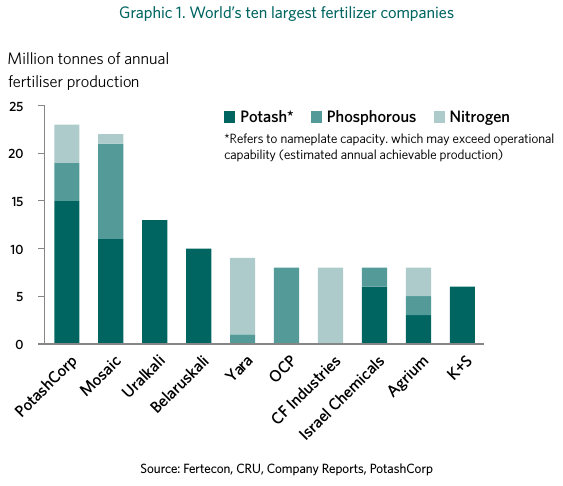
It goes without saying that oil and coal companies should not have a seat at the policy table for decisions on climate change. Their profits depend on business-as-usual and they’ll do everything in their power to undermine meaningful action.
But what about fertilizer companies? They are essentially the oil companies of the food world: the products they get farmers to pump into the soil are the largest source of green-house gas emissions from farming. Fertilizers, too, have their fortunes wrapped in agribusiness-as-usual and the expanded development of cheap sources of energy such as fracked shale gas.
Exxon and BP must envy the ease their fertilizer counterparts have had in infiltrating the climate change policy arena. When world leaders convened for the 21st Conference of the Parties (COP21) in Paris in December, only one major intergovernmental initiative emerged to deal with climate change and agriculture — and it was controlled by the world’s largest fertilizer companies.
The Global Alliance for Climate Smart Agriculture, launched at the 2014 United Nations (UN) Summit on Climate Change in New York, was the culmination of several years of efforts by the fertilizer lobby to block meaningful action on agriculture and climate change. The Alliance’s 29 non-governmental founding members included three fertilizer industry lobby groups, two of the world’s largest fertilizer companies (Yara of Norway and Mosaic of the United States), and a handful of organizations working directly with fertilizer companies on climate change programs. Today, 60 percent of the private sector members of the Alliance still come from the fertilizer industry.
Corporate smart agriculture
One possible explanation for the fertilizer industry’s successful policy coup is that its role in climate change is poorly understood and severely underestimated. People associate Shell, not Yara, with fracking. But in Europe, it is Yara that coordinates the corporate lobby for shale gas development, and it is Yara and other fertilizer companies that suck up most of the natural gas produced by the fracking boom in the United States
Fertilizers, especially nitrogen fertilizers, require an enormous amount of energy to produce. Estimates are that fertilizer production accounts for one to two percent of total global energy consumption and produces about the same share of global greenhouse gas (GHG) emissions. This production gets bigger every year. Supplies of nitrogen fertilizer, which is produced almost entirely from natural gas, are expected to grow nearly 4 percent per year over the next decade. And this production will increasingly rely on natural gas from fracked wells, which leak 40 to 60 percent more methane than conventional natural gas wells. (Methane is 25 times more potent than CO2 as a greenhouse gas.)
Production, however, accounts for only a small fraction of the GHG emissions generated by chemical fertilizers. Most emissions occur once they are applied to the soil.
The International Panel on Climate Change (IPCC) estimates that for every 100 kg of nitrogen fertilizer applied to the soil, one kg ends up in the atmosphere as nitrous oxide (N2O), a gas that is 300 times more potent than CO2 as a greenhouse gas and is the world’s most significant ozone-depleting substance. In 2014, this was equivalent to the average annual emissions of 72 million cars driven in the US — about a third of the U.S. fleet of cars and trucks.
New research, however, shows that these alarming numbers are at least three to five times too low. The use of chemical fertilizers this year will likely generate more GHG emissions than the total emissions from all of the cars and trucks driven in the United States.
The fertilizer industry has long known that their chemicals are cooking the planet and a growing body of evidence shows that their products are not needed to feed the world. Farmers can stop using chemical fertilizers without reducing yields by adopting agroecological practices. This was the conclusion supported by the 2008 International Assessment of Agricultural Knowledge, Science and Technology for Development (IAASTD) — a three-year intergovernmental process involving over 400 scientists that was sponsored by the World Bank and all of the relevant UN agencies.
Faced with this dilemma, the fertilizer companies have moved aggressively to control the international debate on agriculture and climate change, and to position themselves as a necessary part of the solution.

(Image: Pawel Kuczynski)
Fronting for fertilizers
“There have been several organizations advocating at the international level for sustainable agriculture to be interpreted as synonymous with agro-ecology. However, agro-ecology has unfortunately come to represent principles which reject the use of farming inputs. Therefore, initiatives such as the Global Alliance for Climate Smart Agriculture are important to ensure the UN system adopts decisions that are reflective of modern agriculture.” —Canadian Federation of Agriculture
The global fertilizer industry is dominated by a handful of corporations. Yara, which is over 40 percent owned by the Norwegian government and its state pension fund, dominates the global market for nitrogen fertilizer, while US-based Mosaic and a few companies in Canada, Israel and the former Soviet Union operate cartels that control the global potash supply. Mosaic is also the leading producer of phosphates.
These companies are collectively represented by a number of lobby groups. The main ones at the global level are The Fertilizer Institute, the International Fertilizer Industry Association and the International Plant Nutrition Institute. Fertilizer companies are also represented by energy consumer lobby groups such as the International Federation of Industrial Energy Consumers. Yara chairs its Gas Working Party, which, in collaboration with Fertilizers Europe, is lobbying heavily for shale gas development in the European Union (EU).

The fertilizer companies and their front groups play an active role in various alliances that they have formed with other corporations from the food and agriculture sectors to define and protect their collective interests on policies related to the environment and climate change.
In North America, for instance, Yara and other fertilizer companies and lobby groups co-founded the Alliance for Sustainable Agriculture (“Field To Market”) alongside other major food and agribusiness companies like Walmart, Kellogg’s and Monsanto. Also active in this alliance are big U.S. environmental non-governmental organizations (NGOs) such as the Environmental Defense Fund (EDF) and the The Nature Conservancy (TNC). These NGOs work directly with Yara, Mosaic and other fertilizer companies on “climate smart” fertilizer efficiency programs that Walmart, PepsiCo, Campbell’s and other major food companies and retailers are using as a basis for their internal GHG emissions reduction plans
The same NGOs and fertilizer front groups are behind Solutions From the Land, a U.S. alliance of agribusiness corporations and corporate farmers established to defend industrial agriculture from environmental regulations. Initially Solutions From the Land worked to protect industry from regulation of chemical fertilizer run-off, which fouls public water resources, and is now focusing on climate change.
“We’re scared to death we’ll get hijacked by some groups that oppose technology,” explains Solution from the Land’s Fred Yoder, speaking in Abu Dhabi in March 2015 at an agribusiness forum on climate change.
In early 2015, Solutions from the Land changed its name to the North American Alliance for Climate Smart Agriculture and now acts as the regional coordination for the Global Alliance for Climate Smart Agriculture.
This cozy relationship between the fertilizer industry and other multinationals of the food and agribusiness sector reaches beyond the United States and EU. Yara is particularly active within the World Economic Forum (WEF) where it co-chairs the development of its New Vision for Agriculture with Walmart. Yara also chairs the WEF’s Climate Smart Agriculture working group, through which it coordinates the implementation of “climate smart” fertilizer programs with Nestlé, PepsiCo, Syngenta and other companies in Asia and Africa.

Joergen Ole Haslestad, Chief executive officer of Yara International ASA, the world’s largest producer of nitrogen fertilizer and member of the steering committee of the Global Alliance for Climate Smart Agriculture. (Photo: Heidi Wideroe / Bloomberg)
Fertilizer companies also have a long-standing relationship with the international research centers of the Consultative Group for International Agricultural Research (CGIAR). Today, the fertilizer industry collaborates with these centers on various climate smart initiatives in the South. The relationship extends to the Bill Gates-funded Alliance for a Green Revolution in Africa (AGRA), which has several areas of cooperation with the CGIAR and the fertilizer industry, such as the African Green Revolution Forum that was established by Yara and AGRA in 2010.
The main vehicle for the promotion of fertilizers in the Global South, however, is the International Fertilizer Development Center (IFDC), which was established in the United States in the 1970s and is funded by several fertilizer companies, including Yara. IFDC lobbies governments for policies that increase fertilizer use and promotes different fertilizer application techniques, such as integrated soil management that AGRA, the World Bank and other funding agencies have embraced as “climate smart”.
All of these various corporations, agencies, front groups and alliances have converged behind a common effort to promote “climate smart agriculture” as the official response to climate change. It builds upon previous, equally abstract terms promoted by the fertilizer industry to cast chemical fertilizers as part of the solution to climate change, such as “climate compatible agricultural growth” and “sustainable intensification”.
“I believe 2015 and 2016 will be the years where we move from building a global movement to action on the ground. And the key words are climate smart agriculture, an area where Yara has products and knowledge,” says Sean de Cleene, Yara’s vice president of Global Initiatives, Strategy and Business Development.
The UN’s Food and Agriculture Organization (FAO) first coined the term “climate smart agriculture” in 2010 as a means to attract climate finance to its agricultural programs in Africa. The term only became significant in international policy circles in 2012 after the Second Global Conference on Agriculture, Food Security and Climate Change, organized in Hanoi by the World Bank and FAO and hosted by the Government of Vietnam.
The choice of Vietnam was no accident. Yara and other food and agribusiness multinationals of the WEF had recently launched a major public-private partnership with the Vietnamese government under which these corporations were given exclusive responsibility over the “value chains” of the country’s main export commodities. Yara was put in charge of coffee and vegetables, and the programs in Vietnam were adopted as the WEF’s first pilot project for climate smart agriculture, which Yara was tasked with overseeing.
The program of the Second Global Conference was dominated by Yara and the other corporations collaborating with the Vietnamese government. Civil society organizations were marginalized from the discussions, and their vocal rejection of the “climate smart agriculture” concept was ignored. While the previous conference had called for a “paradigm shift at all levels”, this time the conference ended with a call for “a paradigm shift in the role of the private sector” to “institutionalize and scale-up” private sector involvement and “move from public-private to private-public partnerships.”
By the time of the Third Global Conference in South Africa in 2013, the fertilizer lobby and its allies had produced a plan for the creation of an Alliance for Climate Smart Agriculture to be formally presented at the UN Climate Summit in September 2014 as the international community’s main platform for action on climate change and agriculture.
The U.S. State Department then took the lead in moving the plan forward. At the Alliance’s “Partner Meeting” in The Hague in July 2014, where the final details were hammered out, the United States sent five government officials, four representatives of U.S. agribusiness lobby groups and four corporate representatives — a number equal to the entire number of delegates from developing countries.
“The international discussions were hijacked by agribusiness companies, the World Bank, the US and other climate smart agriculture-friendly governments,” says Hans Herren, a Swiss farmer, entomologist and winner of the 1995 World Food Prize. “They have the money and the lobby groups. Those of us defending agroecology, local food systems and small-scale farming as the holistic and truly climate friendly solution were simply pushed out of the process.”
Today the Global Alliance for Climate Smart Agriculture is stacked with fertilizer companies, fertilizer front groups, and NGOs and companies that work directly with them. Its steering committee includes Yara, Mosaic, EDF and TNC, as well as their home governments of Norway and the United Sates.
Back to a paradigm shift
Food and agriculture are low hanging fruits for action on climate change. Dramatic and rapid reductions in greenhouse gas emissions can be achieved in our food systems without major economic consequences. The elimination of chemical fertilizers is one of the easiest and most effective places to start.
Cutting out chemical fertilizers could reduce annual global greenhouse emissions by as much as 10 percent. Additionally, the shift from chemical fertilizers to agroecological practices would allow farmers to rebuild organic matter in the world’s soils, and thus capture a possible two-thirds of the current excess CO2 in the atmosphere within 50 years. There are also the added benefits of improved livelihoods for farmers, more nutritious foods, protection of the ozone layer and safe water systems.
No technical hurdles stand in the way. Fertilizer companies may claim that if we stopped using their products we would have to plough up the earth’s remaining forests in order to meet global food needs, but there are plenty of studies showing that farmers using simple agroecological practices can produce as much food without chemical fertilizers on the same amount of land.
When it comes to global food security, we should be much more worried about our dependence on the cartels that the fertilizer companies operate. During the 2007 food price crisis, as a billion people starved because they could no longer afford food, the fertilizer companies jacked up their prices and held governments and farmers at ransom. They pointed to rising costs for raw materials (natural gas) but the profits of Yara and Mosaic jumped a staggering 100 percent that year.
Kicking the fertilizer habit is really a matter of politics. No meaningful action can occur until the fertilizer industry’s grip on policy makers is loosened.
This report, originally published ahead of the COP21 conference in Paris, is reposted here with permission from GRAIN.org. For additional information, background and citations, clck here.




